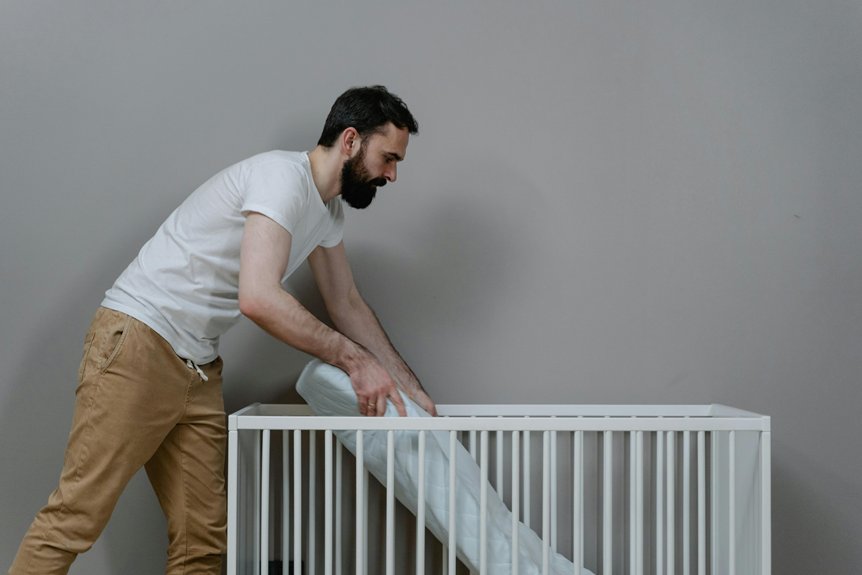Struggling to find a safe, breathable crib mattress that ensures your baby’s health and comfort? Expert-backed mattresses like Naturepedic and Avocado meet strict federal safety standards while offering organic, breathable materials that reduce chemical exposure and promote airflow. Clinically reviewed for firmness and hygiene, these mattresses provide the ultimate peace of mind for safe sleep. Keep reading to discover the top crib mattresses designed to protect your baby and enhance restful nights.
Top Crib Mattresses for Safety and Comfort
Best Crib Mattresses for Safety and Comfort in 2024
How to Choose a Safe and Comfortable Crib Mattress
Naturepedic Organic Mattress Review: Comfort & Durability
Avocado Organic Mattress: Pros and Cons for Babies
Is Lullaby Earth Mattress Safe and Easy to Handle?
Do All Top Crib Mattresses Meet Federal Safety Standards?
Why Choose Organic Mattresses for Infant Sleep Safety?
Features That Enhance Breathability in Crib Mattresses
- How Does Core Design Improve Crib Mattress Breathability?
- Why Choose Waterproof Covers for Crib Mattress Ventilation?
- When to Use Removable Covers for Cleaner Crib Mattresses?
- What Certifications Ensure Safe, Breathable Crib Mattresses?
Comparing Organic and Conventional Crib Mattresses
Organic vs Conventional Crib Mattresses: Which Is Safer?
What Are the Benefits of Organic Crib Mattresses?
How to Clean Organic Crib Mattresses Without Waterproof Covers
Do Conventional Crib Mattresses Emit Harmful Chemicals?
Why Choose Waterproof Conventional Crib Mattresses?
How to Balance Cost and Care When Choosing a Crib Mattress
How to Choose the Right Crib Mattress for Your Baby
How to Choose a Firm Crib Mattress for Safe Baby Sleep
Why Lightweight Crib Mattresses Make Changing Sheets Easier
Which Safety Certifications Matter for Baby Crib Mattresses?
What Are the Best Non-Toxic, Waterproof Crib Mattress Covers?
Frequently Asked Questions
How Often Should I Replace My Baby’s Crib Mattress?
Q: How often should I replace my baby’s crib mattress?
A: Replace your baby’s crib mattress every 3 to 5 years to ensure safety and comfort, as recommended by pediatric sleep experts.
Q: When is it time to change a crib mattress?
A: Change the crib mattress immediately if you notice wear, stains, or damage to maintain a healthy sleep environment for your infant.
Q: Can an old crib mattress be unsafe for my baby?
A: Yes, an old or damaged crib mattress can compromise support and hygiene, so timely replacement supports your baby’s health and safety.
Can Crib Mattresses Help Reduce Allergy Risks?
Q: Can crib mattresses reduce allergy risks for babies?
A: Yes, crib mattresses made with allergy-proof and hypoallergenic materials can help minimize exposure to allergens, promoting a safer sleep environment for infants. Experts recommend these options to protect sensitive skin and reduce allergy concerns.
Q: Are hypoallergenic crib mattresses better for babies with allergies?
A: Hypoallergenic crib mattresses are designed to resist dust mites, mold, and other allergens, making them a suitable choice for babies prone to allergies. Pediatricians often suggest these mattresses to support healthier sleep conditions.
Q: What materials in crib mattresses help prevent allergies?
A: Materials such as organic cotton covers, memory foam with antimicrobial properties, and allergen-resistant fabrics help reduce allergen buildup in crib mattresses. Using these materials can contribute to a baby’s comfort and allergy risk reduction.
Are There Specific Mattress Sizes for Portable Cribs?
Q: Do portable cribs have standard mattress sizes?
A: Portable crib mattress sizes vary by brand and model, so it’s important to check specific dimensions before purchasing a mattress. Choosing the correct size ensures your baby’s safety and comfort during travel.
Q: How can I find the right mattress size for a portable crib?
A: Measure your portable crib or refer to the manufacturer’s specifications to select a mattress that fits securely without gaps. Proper fitting mattresses support safe sleep environments recommended by child safety experts.
What Certifications Ensure Mattress Safety Standards?
Q: What safety certifications should I look for in a mattress?
A: Look for certifications like CertiPUR-US and GREENGUARD Gold, which ensure mattress materials are non-toxic and meet strict safety standards. These certifications help confirm a healthier sleep environment, trusted by experts.
Q: Why is GREENGUARD Gold certification important for mattresses?
A: GREENGUARD Gold certification indicates low chemical emissions, promoting better indoor air quality and safety in mattresses. This standard is widely recognized for supporting healthier sleep spaces.
Q: How does CertiPUR-US certification ensure mattress safety?
A: CertiPUR-US certification verifies that foam mattresses are made without harmful substances such as formaldehyde and heavy metals. It provides assurance of safe, non-toxic materials in your mattress.
Q: Are certified mattresses safer for babies and children?
A: Yes, mattresses with certifications like CertiPUR-US and GREENGUARD Gold are tested for non-toxic materials and low emissions, offering a safer, breathable sleep environment for babies and children. These certifications are trusted by pediatric health experts.
How Do Mattress Protectors Impact Breathability?
Q: Do mattress protectors affect mattress breathability?
A: Yes, mattress protectors made from non-breathable materials can reduce airflow, potentially impacting breathability. Choosing breathable fabrics like cotton or bamboo helps maintain airflow, keeping your mattress comfortable and safe.
Q: Which mattress protector materials are best for breathability?
A: Breathable materials such as cotton and bamboo allow better air circulation compared to synthetic options, supporting a cooler and more comfortable sleeping environment. Experts often recommend these fabrics for optimal mattress protection and ventilation.
Q: How can I ensure my mattress protector does not trap heat?
A: Selecting mattress protectors made from natural, breathable fabrics like cotton or bamboo prevents heat buildup by promoting airflow. This choice supports comfort and safety, especially for babies and those sensitive to temperature.

Leave a Reply